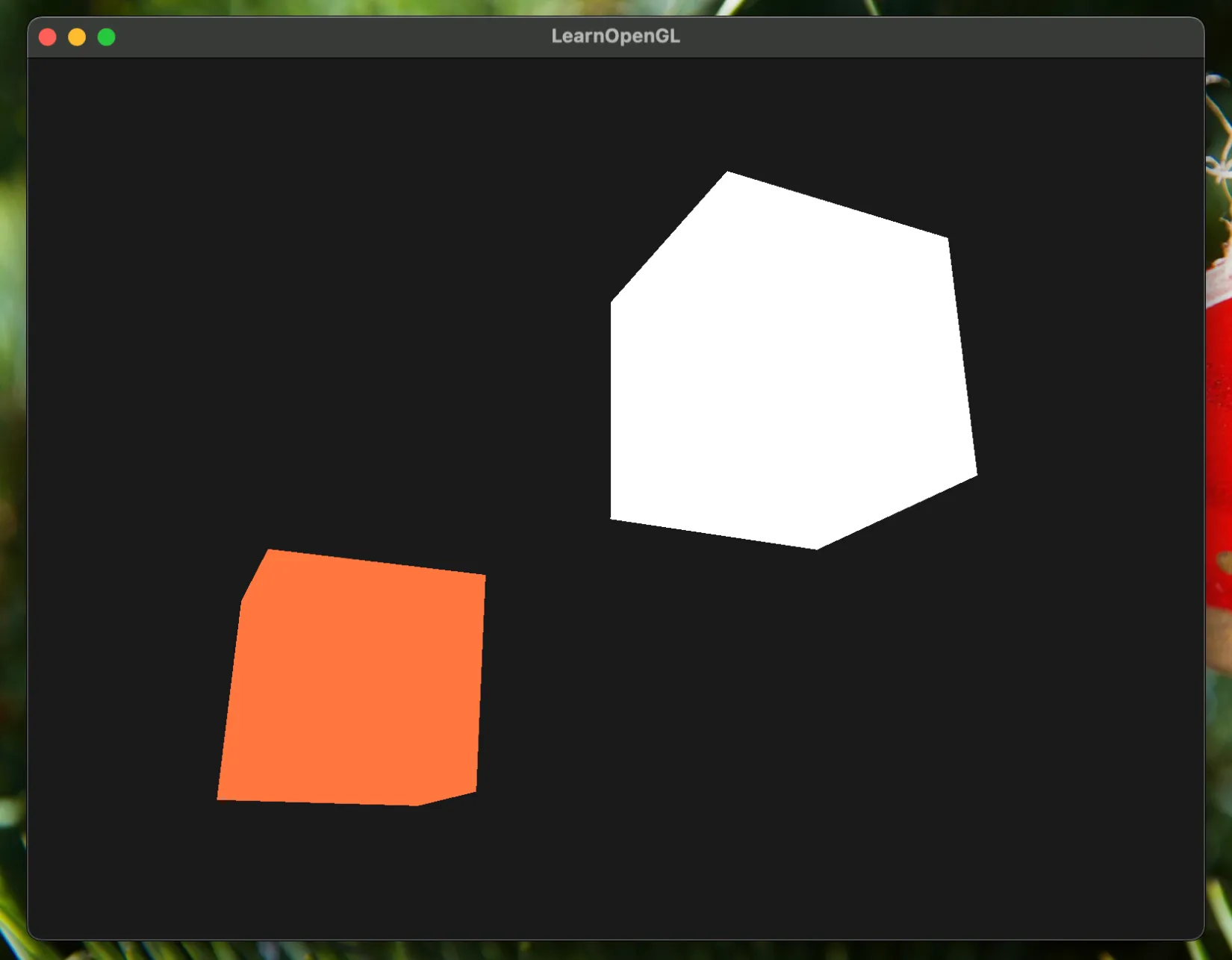Day 4 (Color) - The pain of premature optimization
Jan 28, 2025
int main() {
auto app = PipelineBuilder()
.add_plugin<CameraPlugin>()
.add_plugin<RendererPlugin>()
.build();
auto *rd = app->get_plugin<RendererPlugin>();
auto ss = Shader("shaders/shader.vert", "shaders/shader.frag");
auto ls = Shader("shaders/light.vert", "shaders/light.frag");
rd->add_shader(ss);
rd->add_shader(ls);
auto cubeModel = CubeModel::create();
auto lightModel = cubeModel.copy();
rd->add_model(ss, cubeModel);
rd->add_model(ls, lightModel);
auto cube = Object(glm::vec3(0.0f, 0.0f, 0.0f));
auto light = Object(glm::vec3(1.2f, 1.0f, 2.0f));
rd->add_object(cubeModel, cube);
rd->add_object(lightModel, light);
rd->set_object_hook(cube, [](ObjectHookInput ctx) {
ctx.shader.setVec3("objectColor", 1.0f, 0.5f, 0.31f);
ctx.shader.setVec3("lightColor", 1.0f, 1.0f, 1.0f);
});
app->run();
return 0;
}We… finally did it. We have a pipeline that can register plugins. The plugins can register models, shaders, and objects.
This is done by using a generic PluginBase class that has a virtual void setup() method
and a virtual void update() method. This is inspired by ECS (Entity-Component-System) architecture.
In the future we might want to add a way to register systems and components… and entity as well
because this is nothing like ECS.
I know that reflection (changing behavior i.e. adding systems and components at runtime) can be slower and more error-prone. Also meta programming in C++ is magic, unlike what we are used to in Rust. But since it’s a learning project (and I’m plannnig to ditch C++ soon), I think it’s fine for now.
RendererPlugin
The RendererPlugin is a plugin that is responsible for rendering the scene. Yeah.. of course.
The RendererContext is a struct like this:
struct RendererContext {
std::map<unsigned int, std::reference_wrapper<Shader>> shaders;
std::map<unsigned int, std::vector<std::reference_wrapper<Model>>>
shader_models;
std::map<unsigned int, std::vector<std::reference_wrapper<Object>>>
model_objects;
std::map<unsigned int, std::vector<std::function<void(ObjectHookInput)>>>
object_hooks;
};We had a wrapper class Res<T> that is a resource server that can store things like above,
but I ran into some issues with the difference in implementation so I just use std::map for now.
This is how you can register a shader
void add_shader(Shader &s) const {
ctx->shaders.emplace(s.ID, std::ref(s));
ctx->shader_models.emplace(s.ID,
std::vector<std::reference_wrapper<Model>>());
}So it just inserts the shader into the shaders map and creates an empty vector for the models.
Now we have hiearchy like this:
Shader
Model
Object
HookSo we can run a 4-level nested loop (which can be multi-threaded) to render the scene. Ideally I would want to flatten this but I would like to render 1 shader, 1 model at a time so in order to do that I have to keep the hierarchy.
Adding plugins
This is how you can add a plugin:
template <typename Plugin, typename... Args>
PipelineBuilder &add_plugin(Args &&...args) {
plugins_.emplace_back(
std::make_unique<Plugin>(std::forward<Args>(args)...));
return *this;
}It utilizes the so-called “variadic templates” which is a way to pass multiple arguments.
It’s also what powers std::make_unique and std::forward, as you can see in the code above.
... is so amazing. I want the Pipeline to own the plugins so I use std::unique_ptr.
The pain of premature optimization
The title of this article.
I have been modeling how the hierarchy would look like and how the data would flow.
The previous implementation did not account for how Model might share VBOs.
Also I did not think about the lifetime and ownership of the objects at all.
The same program in Rust would be screamed at multiple times by the borrow checker.
I wasted a lot of time trying to figure these out and I think I should’ve just learn OpenGL not meta-programming in C++. But I guess it’s a good learning experience.
Here is today’s result:
